The Hisense S7NQ Canvas TV is a very interesting proposition, especially for those looking for something in the style of a picture-TV but do not want to spend a fortune. At first glance, it stands out primarily because the gallery mode featuring works of art is completely free – there is no subscription fee, unlike Samsung's The Frame. Moreover, in the box, we immediately get a light brown frame, which will be an additional bonus and savings for many. Although it is designed to display art, it surprisingly performs quite well in other applications as well. The 144 Hz panel, full HDMI 2.1, support for VRR and ALLM – all of this makes gaming on consoles very much possible and quite enjoyable. The Vidaa system operates smoothly, and we find all the essential apps and features here, such as AirPlay, USB recording, and screen mirroring from the phone. But there are also aspects that are a bit lacking. First and foremost – the actual images. Compared to The Frame from Samsung, here they simply look more digital. There is a lack of depth, paint texture, and subtle details that really impress with the competitor. Although at first glance we are dealing with a similar matte panel, in practice it performs significantly worse at suppressing reflections. Colors and blacks fade much faster, especially in a bright room. This might also be due to lower brightness – Hisense is simply darker than its Korean rival. In addition, there are minor glitches in the software – for example, the lack of displaying external subtitles despite the option to configure them, or the not entirely effective image smoothing function with lower quality materials. In short: the S7NQ is a good TV in the form of a "picture," which can be a great alternative for those who do not mind the lower quality of the displayed works but appreciate the absence of subscription fees, the additional frame included, and the full functionality of a typical television. It is not a perfect product, but a reasonable compromise for Samsung The Frame.
- Matching (Score)
- Our verdict
- TV appearance
- Where to buy
- Contrast and black detail
- HDR effect quality
- Factory color reproduction
- Color reproduction after calibration
- Smoothness of tonal transitions
- Image scaling and smoothness of tonal transitions
- Blur and motion smoothness
- Console compatibility and gaming features
- Input lag
- Compatibility with PC
- Viewing angles
- TV efficiency during daytime
- Details about the matrix
- TV features
- Apps
- Playing files from USB
- Sound
Hisense S7NQ CanvasTV vs Hisense E8Q
Direct compare
S7NQ / CanvasTV
E8Q
Available screen sizes: 55”

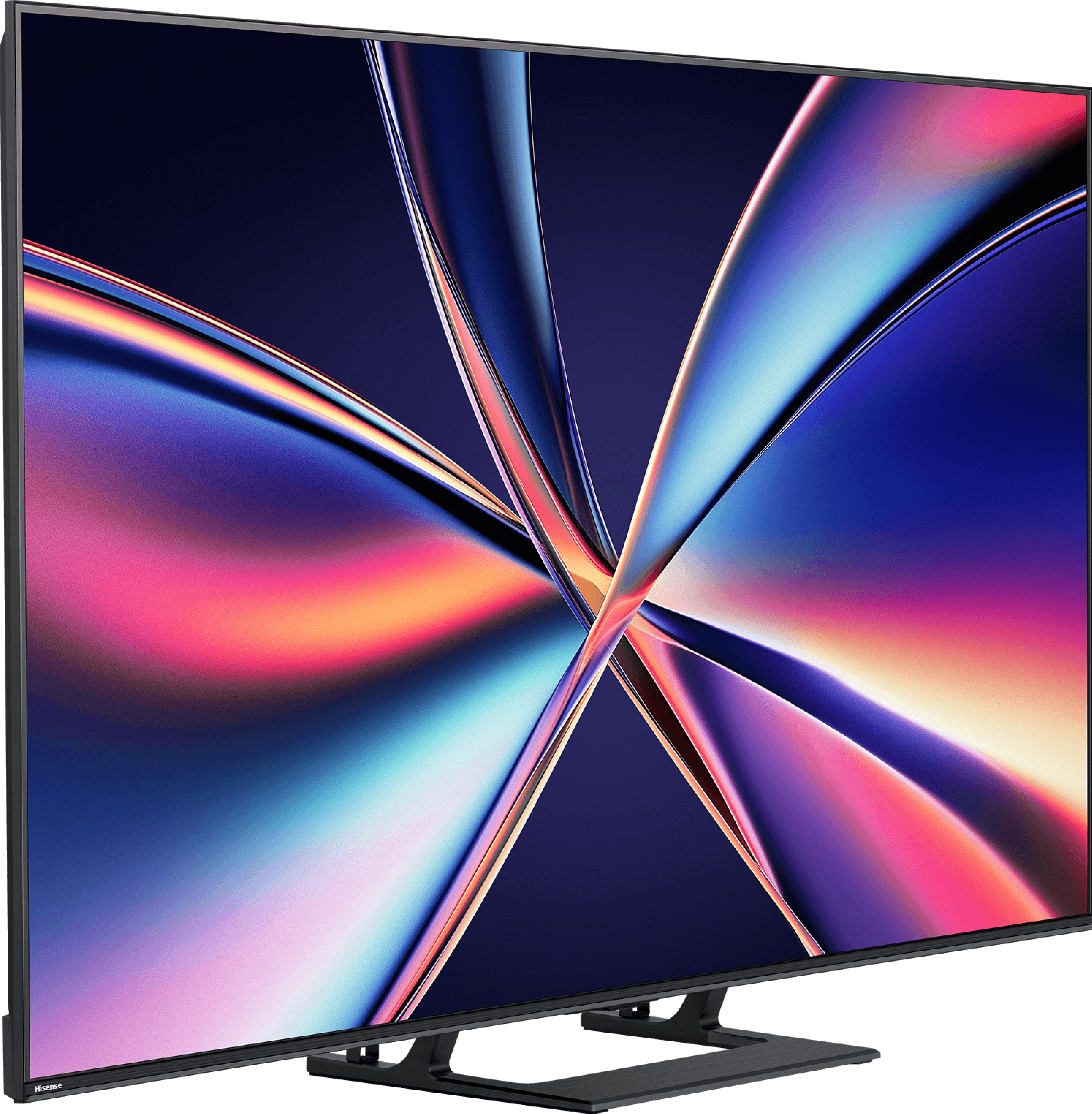
Panel type: LCD VA
Resolution: 3840x2160
System: VIDAA
Model year: 2024
Complete the survey to find out the result

Panel type: LCD VA
Resolution: 3840x2160
System: VIDAA
Model year: 2025
Complete the survey to find out the result

Overall rating
6.7
7.0
Movies and series in UHD quality
6.6
6.7
Classic TV, YouTube
6.3
6.8
Sports broadcasts (TV and apps)
6.1
6.5
Gaming on console
7.5
8.0
TV as a computer monitor
7.0
8.6
Watching in bright light
5.4
6.2
Utility functions
9.0
8.9
Apps
7.7
7.7
Sound quality
6.3
5.5
Complete the survey to find out what fits your preferences
Advantages
Free gallery without a subscription
Frame included
Good for gamers (144 Hz, HDMI 2.1, VRR, ALLM, Game Bar)
Support for Dolby Vision, HDR10, and HDR10+
Decent native contrast (VA Panel)
Works well with PC (chroma 4:4:4)
Fast Vidaa System
Seamless connection to home theaters: Support for Dolby and DTS codecs
Great contrast and deep black
Very good fluidity of tonal transitions (close to reference level)
High brightness
Support for 4K 144 Hz and even 240 Hz in Full HD
VRR, ALLM, G-SYNC – a complete package for gamers
Low input lag
Many classic TV features built into the VIDAA system
Disadvantages
Worse quality of displayed images in gallery mode than in Samsung The Frame
Colors and blacks fade significantly in bright surroundings
No HGiG mode (for gamers)
Software issues - lack of external subtitles display in movies
No support for HGiG (makes HDR setup difficult on consoles)
U7Q
Our verdict
The Hisense E8Q is a television that clearly draws heavily from the U7Q model – and that's a good thing. After all, it is its European version, not another "diet" mutation. Just a few moments with this screen reveal that the E8Q is trying to impress. And in many ways, it really succeeds. Right off the bat – what stands out: the black is deep, the contrast is high, and the brightness exceeds the threshold that we can simply call satisfying. Let's add to that almost perfect smoothness in tonal transitions, and we have an image that looks very mature, especially for this price segment. In gaming? Just as good. It supports VRR, ALLM, 144 Hz in 4K, and even 240 Hz in Full HD – it's hard to find fault here. Well… almost. Because the E8Q has one additional flaw compared to the U7Q – the sound. In our unit, even at moderate volume levels, the back of the casing started to resonate, generating quite unpleasant crackling noises. This might be a flaw in the test sample, but since the U7Q simply performed better – it's worth noting. Especially if you find both models at a similar price. We can confidently state that the E8Q is a television that can boldly compete for the attention of those looking for a quality Mini-LED at a reasonable price. If a good deal comes along, it's definitely worth it – because we get almost the same as with the U7Q. And that means a really solid picture, excellent gaming features, and overall very good equipment that you can stick with for a long time.
TV appearance




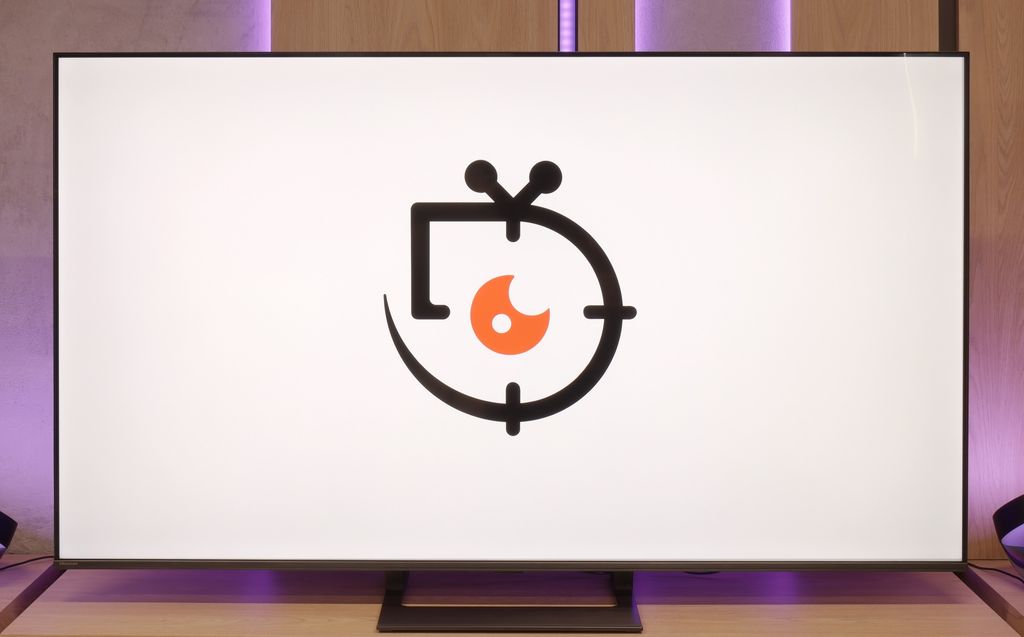
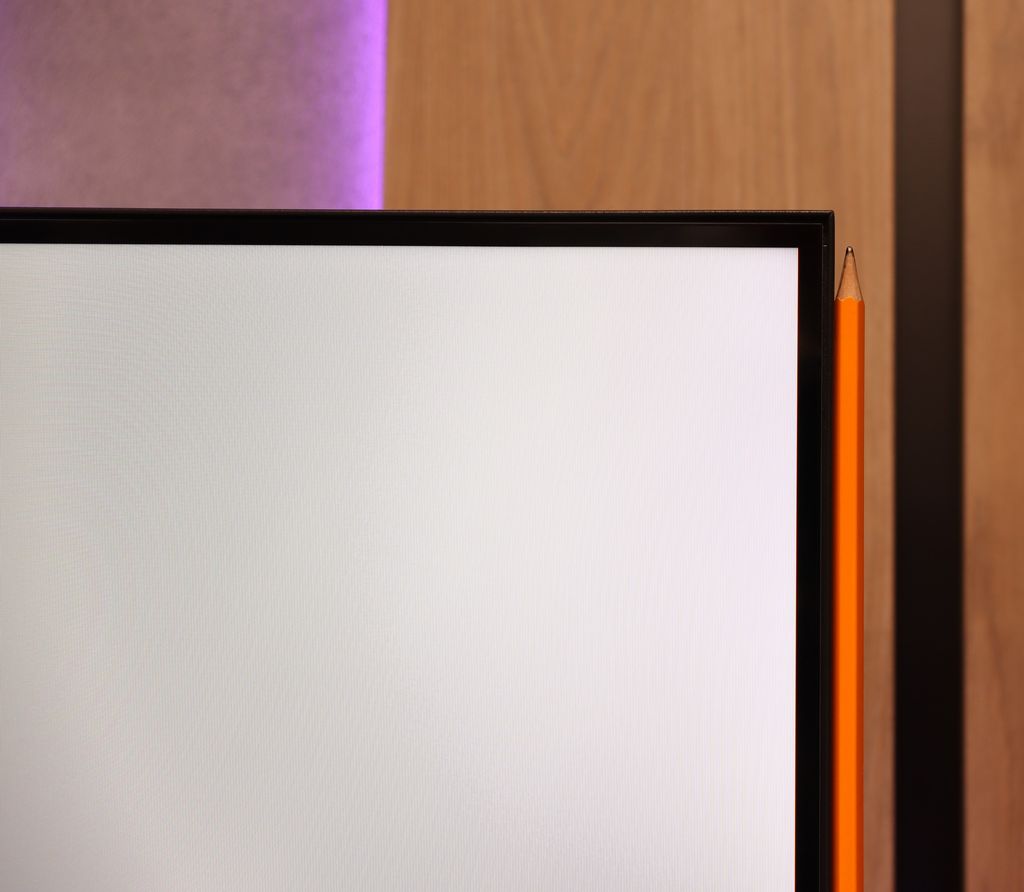
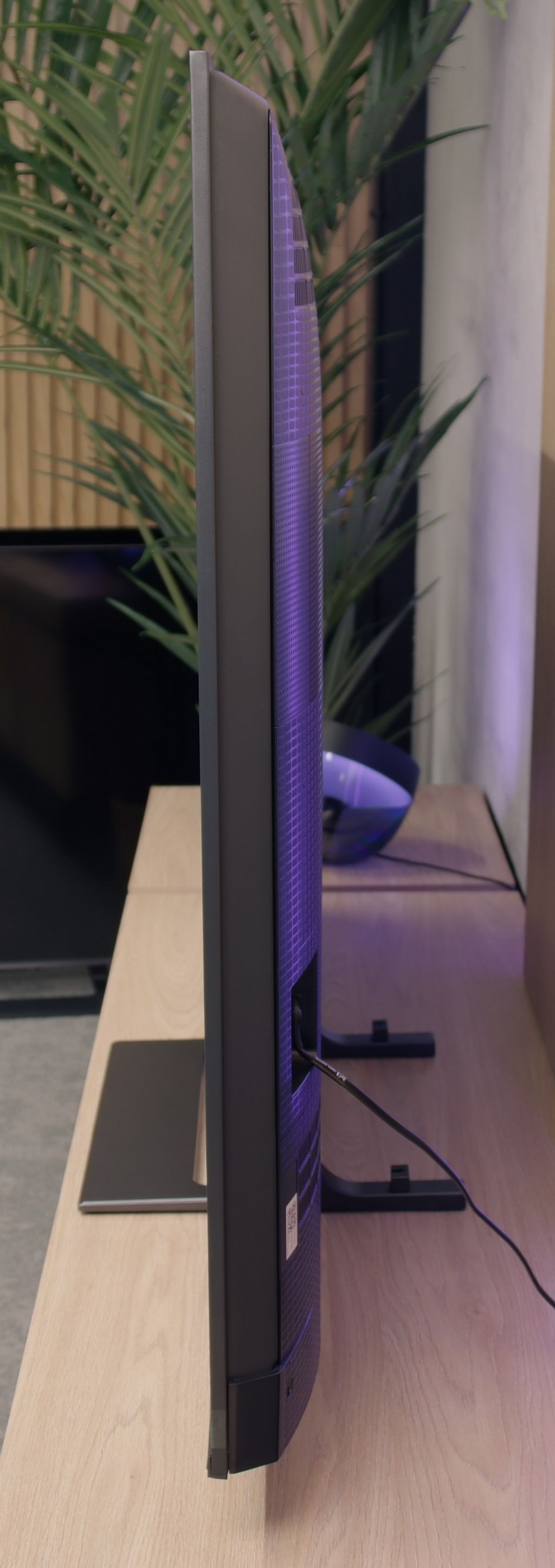
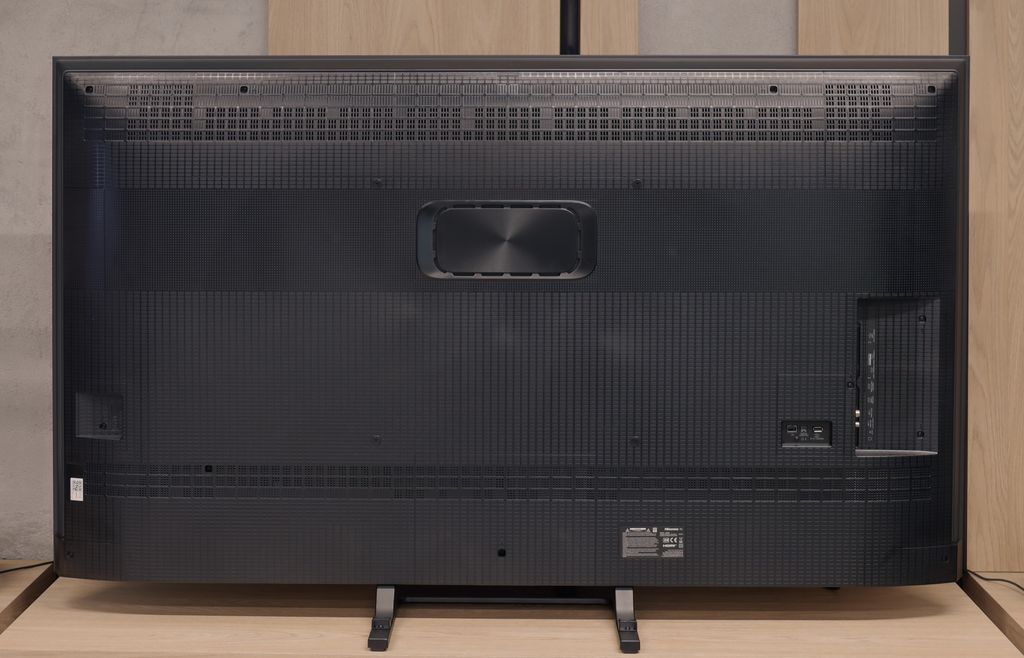
Contrast and black detail
5.6/10
7.6/10
Local dimming function: No
Local dimming function: Yes, number of zones: 220 (10 x 22)
Contrast:

Result
3,400:1

Result
4,200:1

Result
5,200:1

Result
5,050:1

Result
3,650:1

Result
277,000:1

Result
43,700:1

Result
15,750:1

Result
8,850:1

Result
6,350:1
Halo effect and black detail visibility:

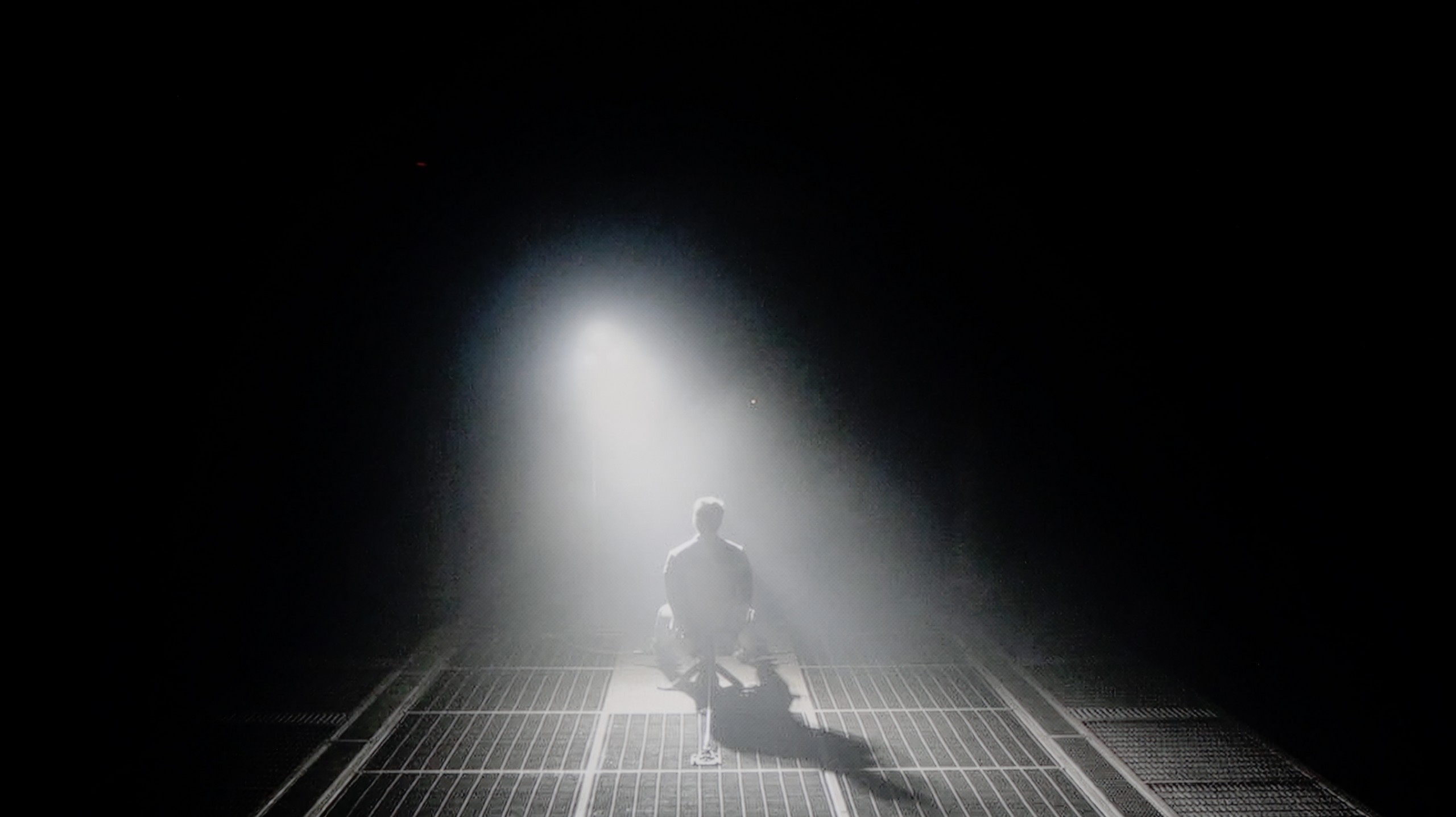
The Hisense S7NQ CanvasTV is a television equipped with a VA panel, which by itself provides decent contrast. Our test patterns confirm this – the average score is around 4000:1. While this may not be an exceptional value, for this class of device, it's quite acceptable. The result might have been significantly better if the television had been equipped with local dimming technology; unfortunately, this model lacks it. As a result, blacks in a completely dark room resemble shades of navy or gray more than pitch black. This situation leads to a slightly visible clouding effect. Overall, it's fine, but without much excitement.
Similarly to the U7Q, the E8Q model uses a VA panel and Mini-LED backlighting. The number of dimming zones also remains at a very similar level – in the 65-inch variant we tested, we counted 220 zones, which is exactly the same as in the U7Q. On paper, this looks really good for this price segment, but even better – in practice. The contrast is high, and black can be really deep. In many scenes, the lights are clearly separated, and the image gains in spaciousness. This is one of those cases where Mini-LED shows it can approach the quality of OLEDs – provided that we are aware of the limitations we need to consider. In very difficult scenes, there may be slight lightening or minor halo effects around bright objects, but these are phenomena typical of this technology and are not very noticeable. Ultimately – the contrast and blacks in the E8Q are really solid, almost identical to those in the U7Q model. It’s hard to find fault with this, especially when we look at the price of the television.
HDR effect quality
5.6/10
4.5/10
Luminance measurements in HDR:

Result
455 nit

Result
414 nit

Result
438 nit

Result
451 nit

Result
470 nit

Result
531 nit

Result
148 nit

Result
320 nit

Result
100 nit

Result
625 nit
Scene from the movie “Pan” (about 2800 nits)


Scene from the movie “Billy Lynn” (about 1100 nits)


Static HDR10


Dynamic: Dolby Vision
Dynamic: Dolby Vision


HDR luminance chart:
Hisense E8Q
Luminancja HDR
Luminance of RGB colors
Hisense S7NQ CanvasTV
Luminancja HDR
Luminance of RGB colors
When it comes to the brightness of the television and how it handles bright elements while watching movies, it is just average—similar to contrast. The average brightness level of the Hisense S7NQ is around 500 nits. This is a value that allows you to feel the beginnings of true HDR, but it is definitely too little to speak of outstanding effects. However, the television deserves praise for color gamut coverage—movies look very colorful and vibrant. With the use of PFS LED (QLED) coating, the device can cover over 90% of the DCI-P3 color gamut and over 72% of the wider BT.2020 gamut. For a television in this class, these are truly very good results.
Since the E8Q is a twin of the U7Q, it’s no surprise that the quality of the HDR effect is almost identical. On paper, it looks promising – a peak brightness of 800 nits can impress in many scenes. Fragments like the flashes of light in “The Meg” or shots of the sun in “Life of Pi” can indeed evoke a “wow” effect. But the longer we watch, the more we notice the limitations. The problem arises when small, bright details are supposed to be displayed on a dark background. In such situations, the dimming algorithms try to preserve contrast but end up dimming what should shine the brightest. Instead of dazzling details, we get almost invisible points of light. This is typical for Mini-LED in this price segment and is not surprising – but it’s worth knowing that the HDR effect won't always be fully preserved. Fortunately, the color reproduction offers reasons to be satisfied. A coverage of the DCI-P3 color gamut at around 94% is a very good result, and the applied quantum dot layer (more specifically, PFS) does its job – colors are saturated and vibrant, especially with 4K content.
Factory color reproduction
7.2/10
6.5/10


Factory Mode
After calibration
Let's now check how the Hisense S7NQ CanvasTV performs in color reproduction in the best factory mode, which is Filmmaker. Right from the start, it is evident that it is definitely better than in dynamic or standard mode, but there are still a few things to nitpick. In terms of image quality from the HD signal, the colors are slightly inaccurate – there is a dominance of cooler shades of blue and a lack of red. Because of this, the image appears somewhat too cool.
A similar effect occurs with 4K content, but it is more noticeable there. The excessive exposure of blue tones and the lack of red make the image seem distinctly cold. However, the biggest issue with this television is not the colors themselves but rather the way brightness is managed. The tested unit slightly boosted the brightness compared to the reference value. The result is indeed better visibility of details, but at the cost of significantly brightened black – which makes the entire image seem more "flat."
A similar phenomenon was noticed in the 4K signal – the slightly inflated curve at the beginning of the EOTF graph shows that the television has a tendency to excessively expose certain scenes. Fortunately, this effect can be improved with professional calibration, which we will discuss in the next point.
Testing the Hisense E8Q in Filmmaker mode, we were hoping for a neutral image close to the director's vision. Unfortunately - although on paper it doesn't look bad (the color reproduction errors are not significant), in practice the image feels somewhat unnatural. The reason? Too strong an increase in blue and a lack of red in the white balance. The effect? The scenes look cool, and the white appears slightly bluish. Alongside the U7Q model, we also noticed a specific approach to brightness management here. The brightness reproduction curve for HDR content (EOTF) shows that the TV can significantly dim small, bright elements of the screen to maintain contrast - but sometimes it goes too far. On the other hand, it can excessively brighten larger, very bright parts, which disrupts tonal balance. This is a compromise that may not suit everyone – especially if you want an as faithful image as possible right out of the box.
Color reproduction after calibration
8.3/10
7.4/10




The results we achieved after calibrating the Hisense S7NQ are really very good. Thanks to the calibration, we were able to eliminate the excessive exposure of blue tones and the lack of red in the HD signal. A similar, although slightly weaker effect was also achieved with 4K HDR content. Brightness management in HD material has also improved – the television no longer has problems with overall image brightness issues.
However, there are things that cannot be overlooked. The characteristic of the EOTF curve has practically not changed, and the lack of local dimming means that the smallest elements on the screen will always be slightly overexposed. One simply has to accept this when choosing a television with a similar type of backlighting. Nonetheless, the final result is very good and should fully satisfy the vast majority of users.
The calibration of the Movie mode brought really good results, especially regarding SDR content. The white balance was successfully adjusted, which gave the image a natural look – it appeared almost reference-level. The colors were well-saturated, and the overall perception of the content improved significantly. Unfortunately, when we moved to HDR materials, the well-known problems from the U7Q model returned. The TV still tends to “do things its own way,” which is evident from the analysis of the EOTF brightness characteristic – despite calibration, the E8Q still dimmed small details in the shadows, while the bright areas of the screen could sometimes be excessively boosted. In practice, this means that in darker scenes, some of the tiniest details could simply disappear. Although it must be admitted that the entire calibration process brought a lot of good, not everything can be circumvented – even with the use of professional tools. The E8Q can impress with its picture, but in HDR content, its design limitations become noticeable, and it is worth keeping this in mind.
Smoothness of tonal transitions
9.2/10
9.9/10












The smoothness of tonal transitions is one of those categories that even less advanced users can notice. If someone doesn't know what it's about – let us explain. It refers to whether colors blend smoothly or if their "sticking" is visible in the form of distinct bands. Good tonal transitions are those that are natural and smooth, without large jumps in color.
The Hisense S7NQ performs very well in this category, although it must be honestly admitted that it does a bit worse than Samsung The Frame. In very bright scenes, slight imperfections can be noticed, but you really need a keen eye to catch them. Overall – like in most "frame" style televisions – it still performs excellently.
In this category, the Hisense E8Q truly shows its class. The transitions between colors are very smooth, with no "banding" or clear boundaries between tones. The image looks natural, and the color gradient is exceptionally well-executed – even in more difficult scenes. If there are any minor imperfections, they are subtle enough that they don't stand out. It's hard to find fault here – it looks almost exemplary.
Image scaling and smoothness of tonal transitions
5.5/10
6/10
Smooth transition function


Image without overscan on the SD signal


It is equally important how the television handles tonal transitions on a poorer signal – for example, in older movies, television, or on YouTube. Unfortunately, despite the presence of the "Smooth and Gradient Picture" feature, which was supposedly intended to improve this aspect, its performance is truly lacking. It is barely noticeable that it has any real impact on the visibility of color transitions.
Image scaling also performs poorly. Yes, one can observe that the television tries to "stretch" the quality, but the final effect is far from ideal. The image often appears slightly jagged, which is especially noticeable in the case of tree branches in the background. Additionally, the Hisense S7NQ has a clear tendency to crop the image at lower resolutions, which can cause us to miss captions in the news or finer details of the image.
In the case of older materials with lower quality, a gentle smoothing of tonal transitions is often useful. The Hisense E8Q, like the U7Q, has the "Smooth and Gradient Picture" feature, but unfortunately, its effectiveness leaves much to be desired. The “Low” setting is almost imperceptible in operation, while higher settings simply blur details instead of improving transitions. The good news is that the feature does not compromise the film grain, which allows it to maintain the image structure. On the plus side, the scaling is commendable. The television can fairly sensibly transform older content to a higher resolution—without artificially emphasizing contours or excessive sharpening. Though it does not match the best models in this category, it performs quite well for its class.
Blur and motion smoothness
6.5/10
7.5/10


Blur (native resolution, maximum refresh rate):






Blur (BFI function enabled):



Smużenie ():
Smużenie (4K 120Hz):



When it comes to motion fluidity, the television performs really well. Although the S7NQ was mainly designed for displaying static elements – such as images – the manufacturer has utilized a panel with a refresh rate of 144 Hz. As a result, sports or games look really good on it.
For materials that are not recorded at a high frame rate, the manufacturer provided two features that allow you to adjust the picture to your own preferences. "Motion blur reduction" and "motion smoothing" operate on a 10-level scale, allowing you to choose between a more cinematic image – with characteristic frame jumps – and a smooth effect reminiscent of a "soap opera." How to set this up? That's a personal matter – we leave the decision to you.
Like the U7Q, the E8Q model is a fast television designed for dynamic content. It supports 144 Hz refresh rates in 4K resolution, and if for some reason someone is still gaming in Full HD, it can achieve even 240 Hz. This is a significant advantage, especially for PC users looking for maximum fluidity. In everyday use, the television performs very well. The "Ultra Motion Smoothness" mode provides us with two sliders, allowing for personalized image settings – whether it’s more cinematic with preserved film frames or heavily smoothed, almost "series-like." It’s good that the manufacturer gives a choice here instead of imposing one style. On sports materials, live broadcasts, or in games – motion appears clean and stable. Sure, it’s not at the level of OLEDs, but for this price range, the E8Q performs really well.
Console compatibility and gaming features
8.5/10
8.5/10
- ALLM
- VRR
- VRR range48 - 144Hz48 - 240Hz
- Dolby Vision Game Mode
- Correct implementation of HGIG
- 1080p@120Hz
- 1440p@120Hz
- 4K@120Hz
- Game bar



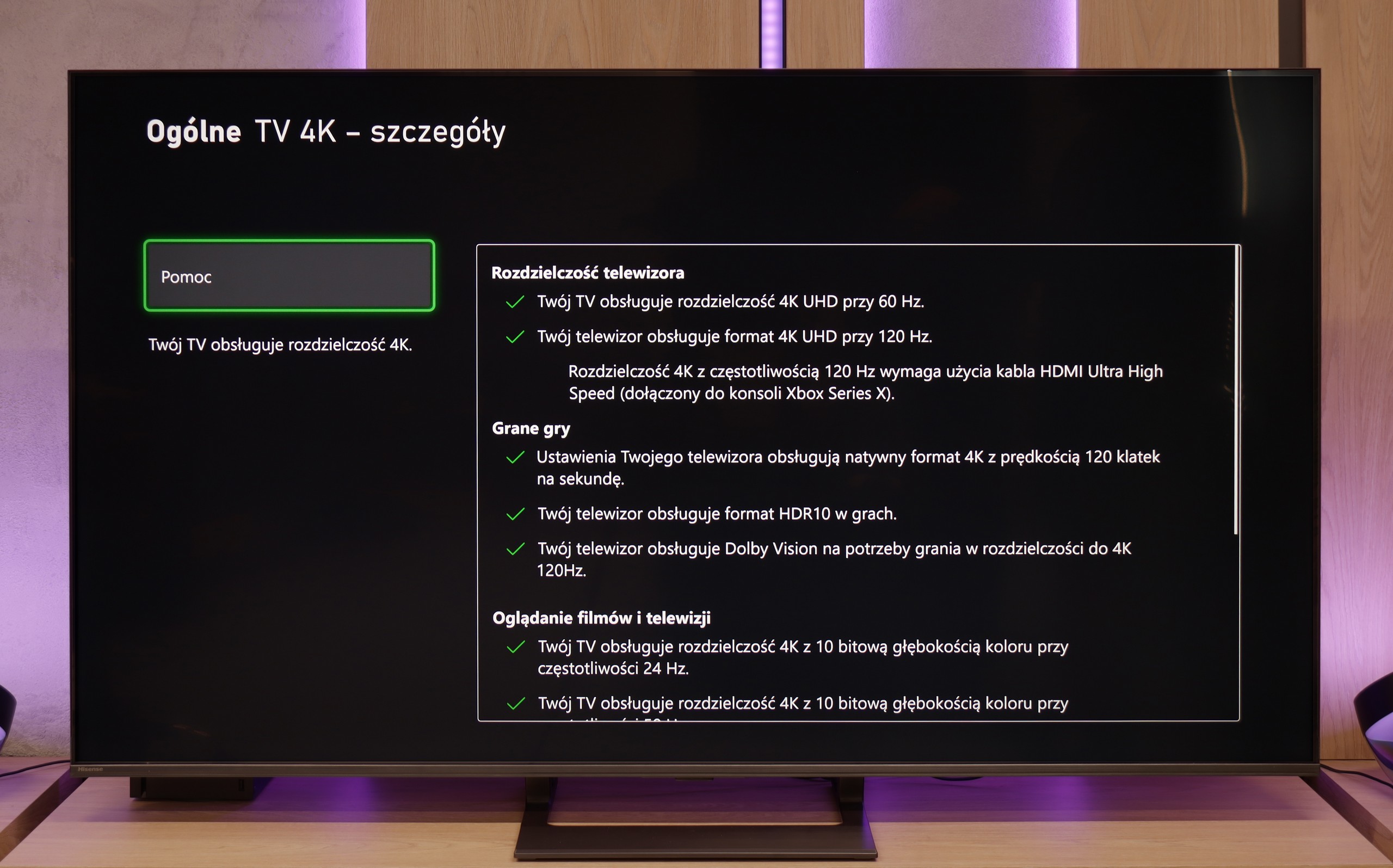

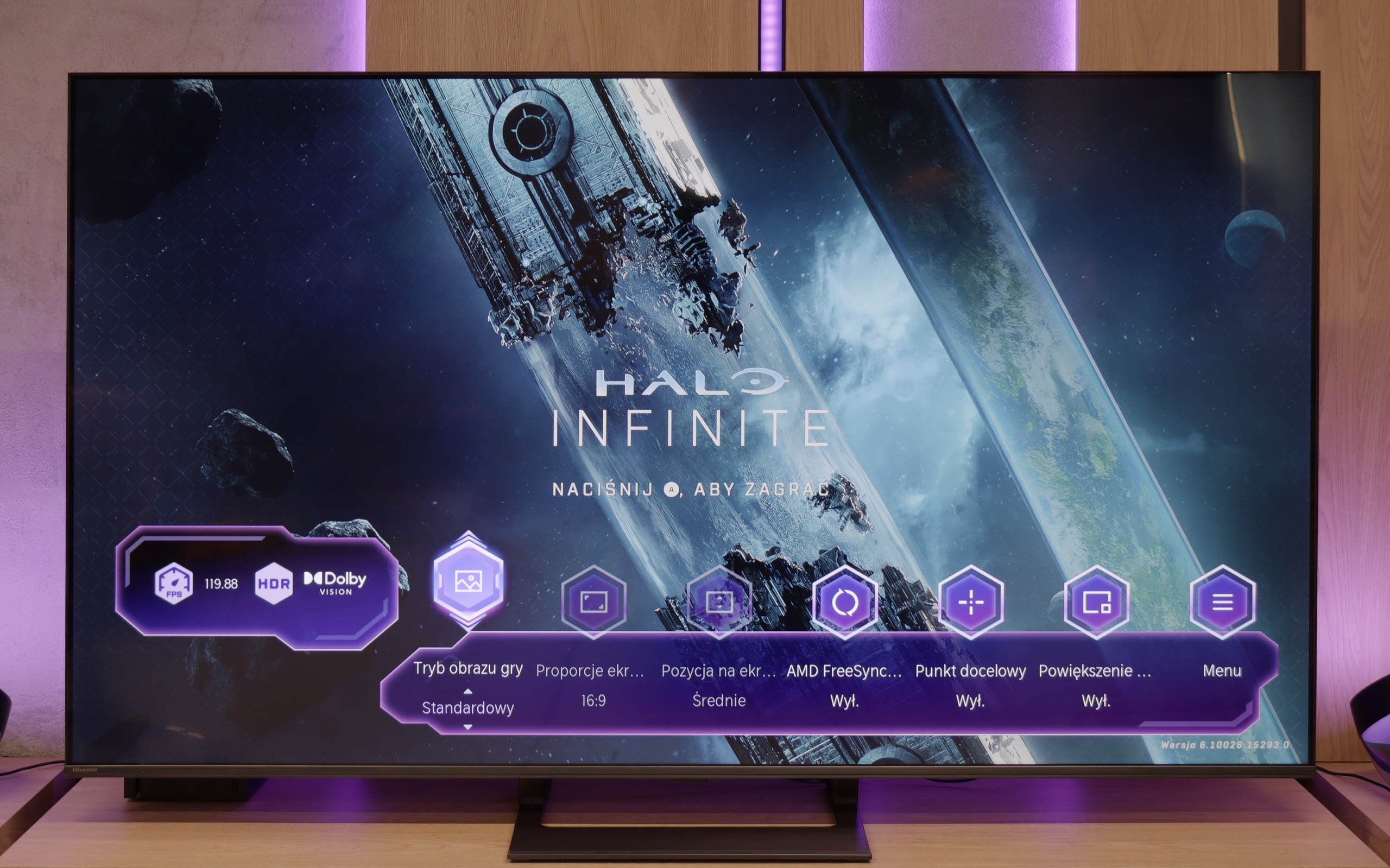


Even though the S7NQ is an "image" type TV, you can actually play games on it. Really. It has almost everything (except for HGiG mode) that a modern gaming TV needs. The 144 Hz panel and two full-fledged HDMI 2.1 ports allow for seamless connection of two consoles, such as PlayStation 5 or Xbox Series X/S.
The TV supports automatic game mode (ALLM) and frame synchronization (VRR) without any stuttering or issues. It also handles high frame rates at lower resolutions without a hitch. We must commend Hisense for the very attractive Game Bar – it displays all available picture options, and additionally, we have the ability to zoom in on the mini-map or enable a crosshair (because sometimes someone might actually want to "aim" 😉).
The only missing element – as we mentioned earlier – is the lack of a proper implementation of HGiG mode. It is responsible for automatically setting the picture in games as the creators intended. It's a shame because that’s the only thing separating the Hisense S7NQ from being a full-fledged gaming "monster."
The Hisense E8Q does not hide its gaming pedigree. The specification alone reveals that we are dealing with a television that will work great as a gaming screen. Variable Refresh Rate (VRR)? Yes. Automatic low latency mode (ALLM)? It's there too. Additionally, there is impressive refreshment – 120 Hz in 4K or even 240 Hz in Full HD. Such a set is rare in this price segment. Everything works smoothly and without major surprises. The only missing element – like in the U7Q – remains support for HGiG. It's a pity, because this feature makes it easier to match the brightness curve to the capabilities of a particular television, improving visual consistency with the intentions of HDR game creators. Without it, one has to manually tweak the settings, which does not always yield a satisfying result.
Input lag
8.7/10
9.7/10
SDR
HDR
Dolby Vision
Input lag on the Hisense S7NQ performs well, although it cannot be said to be outstanding – especially for the standards of 2024/25. Values around 30–20 ms may not be very high and the average player probably won’t notice it, but those who spend a lot of time gaming may feel a slight discomfort.
The situation looks definitely better when playing in Dolby Vision mode – then the delay is lower and gameplay feels more enjoyable. The problem is that there are still few games supporting this mode and they are primarily available on the Xbox console.
The E8Q handles delays very well. For 120 Hz content, the input lag is super low – practically unnoticeable even for more demanding gamers. At 60 Hz, the values are a bit higher, but still comfortably within the "placebo" range – there's nothing to complain about. The biggest increase in lag was noted in Dolby Vision Gaming mode. The TV needs more time to process the signal in this mode, but even then, it does not exceed 30 ms. While these may not be perfect values, they won't pose any obstacles for most gamers – especially console gamers.
Compatibility with PC
7/10
8.6/10


When it comes to working with a computer, the S7NQ Canvas TV performs really well. Gaming on it is seamless thanks to the presence of a 144 Hz panel and support for G-Sync with Nvidia cards. Input lag – as we mentioned earlier – is good, though not outstanding.
And how about working? It’s doable. The TV has a proper implementation of chroma 4:4:4, so fonts look quite sharp. One could nitpick about some minor issues with the thinnest letters on a dark background, but let's be honest – rarely does anyone sit a meter away from a 55-inch screen reading small text.
In terms of collaboration with the computer, the E8Q performs really well. It supports chroma 4:4:4 at full 4K resolution and at the highest refresh rate, so the readability of fonts – even the smallest ones – is at a very good level. There are minor blurriness issues with exceptionally thin fonts, but in everyday use, this is hard to consider a serious problem. A nice addition for PC gamers is the ability to achieve up to 288 Hz at lower resolutions. The E8Q communicates effortlessly with powerful graphics cards, making it an interesting choice not only for movies or consoles but also for gaming on a computer.
Viewing angles
3.4/10
3/10
The viewing angles are typical for a VA matrix. The S7NQ loses quite a bit when viewed at an angle of about 45 degrees – the colors fade, and the brightness drops significantly. It's a pity because, after all, this is a television that is intended to display works of art – it would be nice to be able to look at them from different places in the room, not just straight on.
E8Q, like most TVs with a VA panel, looks best when we sit directly in front of the screen. In this position, one can count on deep blacks, good color saturation, and high contrast. Unfortunately, just moving slightly to the side causes the picture quality to suffer – colors start to fade, and blacks become more gray than black. This isn't surprising, but it's worth keeping in mind, especially if we plan to watch in a larger group from different positions in the living room. As a consolation – in return, we get significantly better black levels than with IPS panels.
TV efficiency during daytime
5.4/10
6.2/10




Matrix brightness
Average luminance SDR
Hisense E8Q: 504 cd/m2
Hisense S7NQ CanvasTV: 497 cd/m2
The Hisense S7NQ Canvas TV is equipped with a matte panel that effectively suppresses reflections – very similarly to its Chinese rival, the TCL A300 NXTVision. Unfortunately, both designs fall short in this category compared to Samsung's The Frame, which offers significantly better anti-reflective coating. In the case of the Chinese models, including the S7NQ, colors fade significantly under light, and black performance in such conditions is weak. The brightness of the television reaches about 500 nits – a pretty decent value for a matte screen, but still lower than that of the aforementioned The Frame. Generally, if someone prefers matte displays, well... it looks like it looks – Samsung simply did it better.
The Hisense E8Q is not afraid of bright interiors. Even when the full sun is shining outside, the television can maintain good image clarity. A brightness level of around 500 nits ensures that you can comfortably watch content during the day, without feeling that everything is drowning in glare. The satin screen coating also helps to pleasantly reduce reflections – it doesn't eliminate them completely, but limits them enough that they don't interfere with everyday viewing.
Details about the matrix
Subpixel Structure:
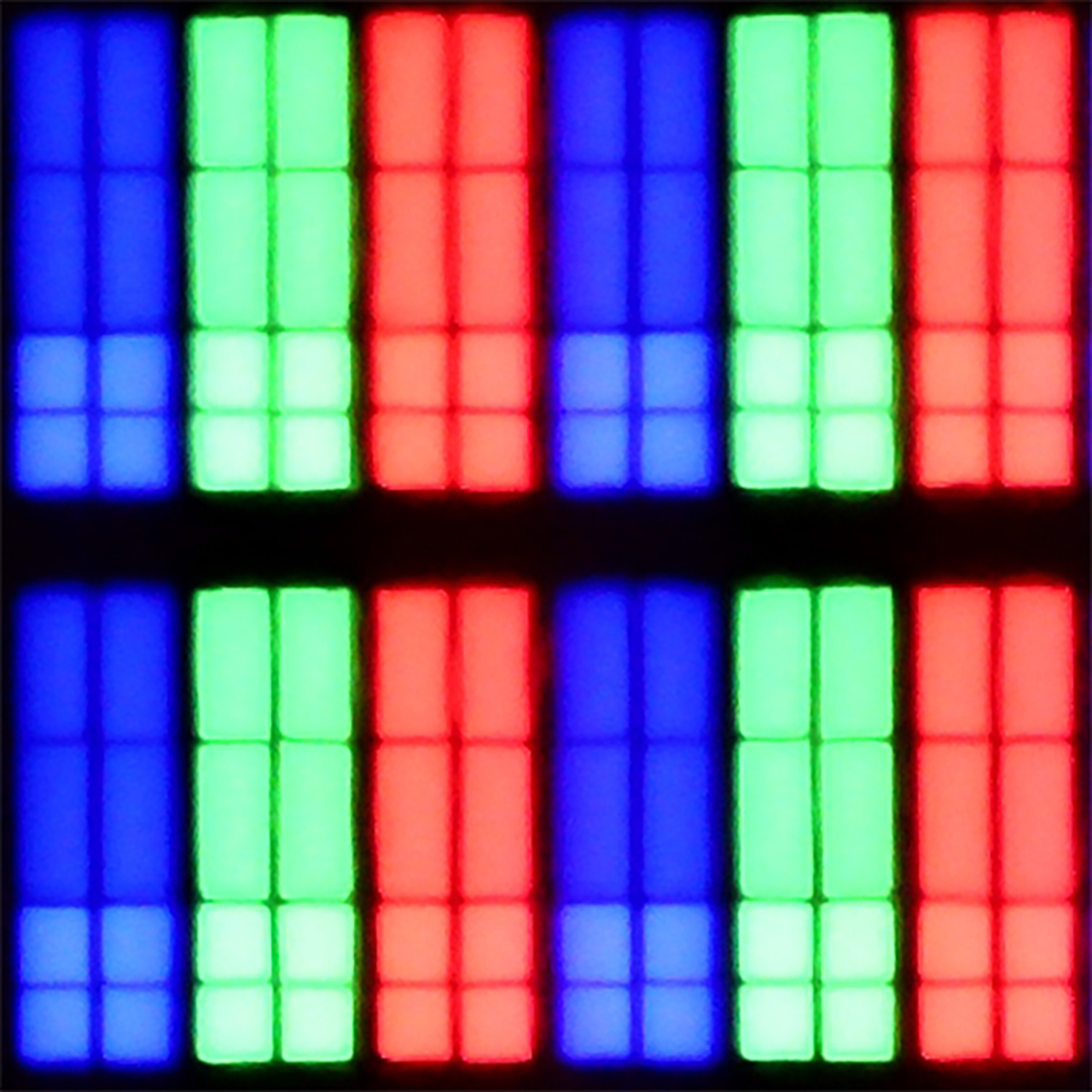
Panel uniformity:


Hisense S7NQ CanvasTV
Hisense E8Q
TV features
9/10
8.9/10
- HDMI inputs2 x HDMI 2.0, 2 x HDMI 2.1 48Gbps2 x HDMI 2.0, 2 x HDMI 2.1 48Gbps
- Other inputsRCA (Chinch)
- OutputsToslink (Optical audio), eARC (HDMI), ARC (HDMI)Toslink (Optical audio), eARC (HDMI), ARC (HDMI), Mini-Jack (Headphones)
- Network InterfacesWi-Fi 2.4GHz, Wi-Fi 5GHz, Ethernet (LAN) 100MbpsWi-Fi 2.4GHz, Wi-Fi 5GHz, Ethernet (LAN) 100Mbps
- TV receptionDVB-T, DVB-T2, DVB-S, DVB-S2, DVB-CDVB-T, DVB-T2, DVB-S, DVB-S2, DVB-C
Classic features:
- Recording to USB (terrestrial TV)
- Recording programming
- Picture in Picture (PiP)
- RF remote control (no need to aim at the screen)
- Backlit remote control
- Teletext
- Audio only mode
- Possibility to connect Bluetooth headphones to the TV
- Possibility to simultaneously use Bluetooth headphones and the TV speaker
Smart features:
- AirPlay
- Screen mirroring (Windows Miracast)
- Wyszukiwanie głosowe
- Voice search in native language
- Ability to connect a keyboard and mouse




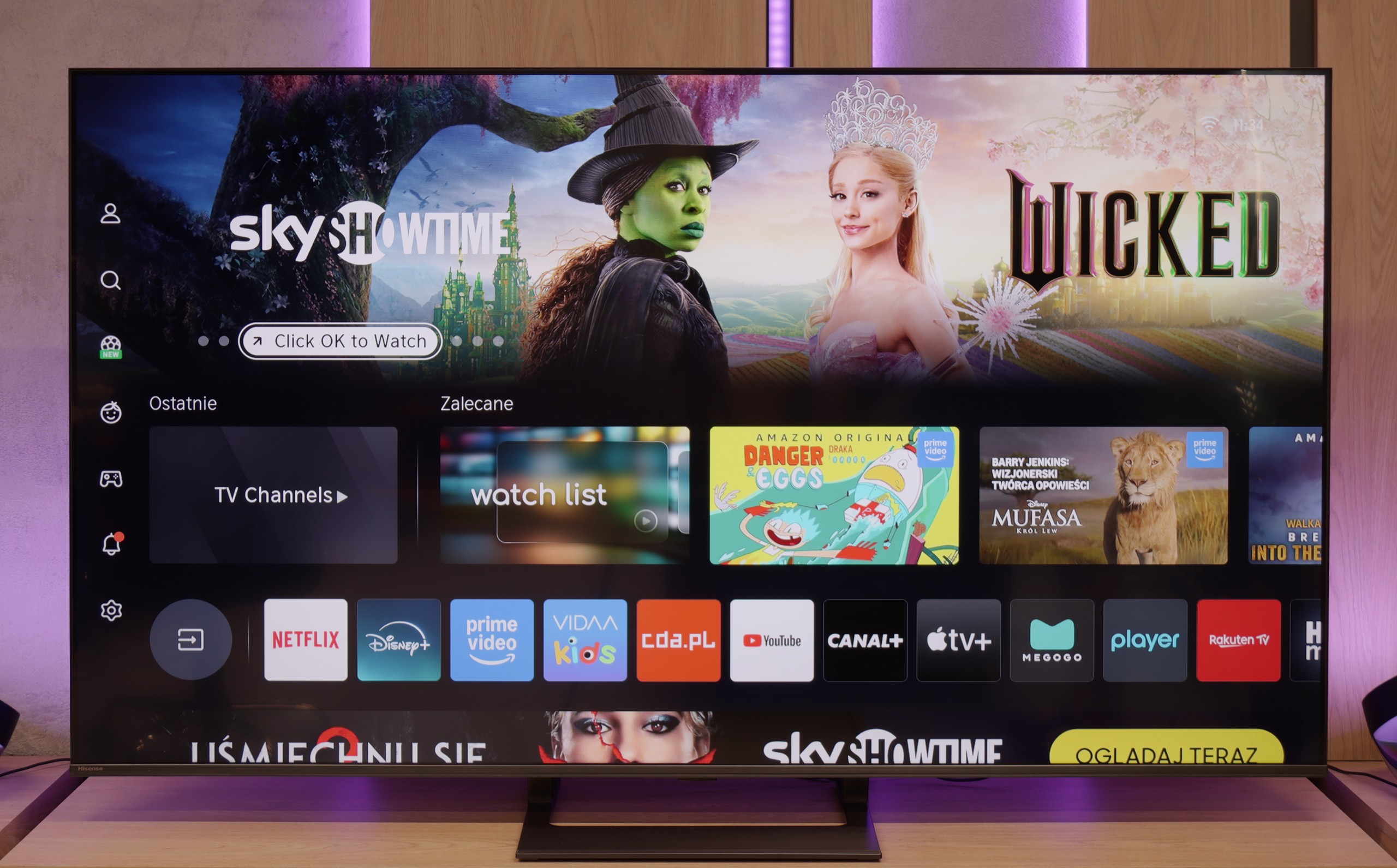
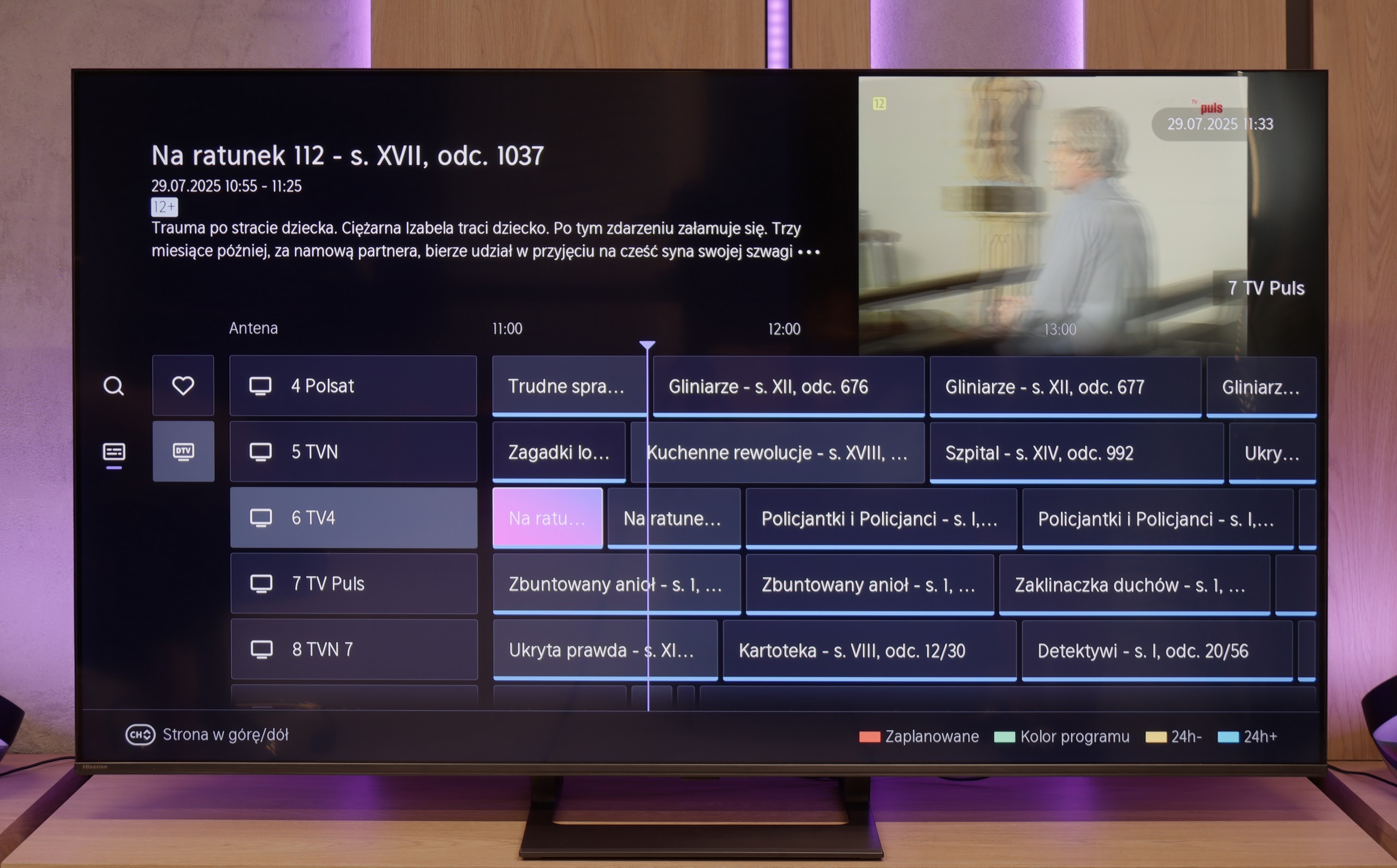


Since the Hisense S7NQ is a special-purpose television, we will start the description a bit differently – with the most important aspect of such models, which is displaying works of art. Like all "art" televisions, it features a special mount that allows the screen to be installed completely flat. The biggest advantage over the Korean Samsung The Frame is the fact that, despite the smaller availability of images in gallery mode, all of them are completely free – there is no subscription fee required. An additional bonus included with the S7NQ is the light brown frame. This is a significant plus, especially if someone was already planning to choose this particular color – it can save some money both on the frame and the subscription.
However, when it comes to the quality of the displayed images, it is unfortunately evident that the Samsung The Frame performs significantly better in this regard. The images in the S7NQ look more digital, while in The Frame, the Art Store mode offers true scans of works of art, where you can even see the texture of the paint or the artist's brush strokes. And again, we return to the old truth – for better quality, you simply have to pay.
Fortunately, the S7NQ is not just an "art", but also a normal television – and in this role, it performs really well. Like most Hisense models with the VIDAA system, we find many basic functions here, such as recording to USB, screen mirroring, and AirPlay support. As for the apps – the most popular streaming services are present, and you can find their full list below.
Classic Features – E8Q
The Hisense E8Q is not only equipment for gamers or movie enthusiasts – it can also serve as a daily television for the entire family. We can record programs to USB, connect headphones or speakers via Bluetooth, and the entire interface – including the channel guide – is clear and easy to use. It only lacks the PiP function, but aside from that, the set of classic features is truly complete.
Smart TV – VIDAA System
The E8Q runs on the VIDAA system, which is becoming more refined year by year. Voice search in Polish works flawlessly, and it's easy to cast from your phone (AirPlay and screen mirroring). The system operates smoothly, without any hiccups, although – as is often the case with closed platforms – there may occasionally be one or two less popular apps missing. Therefore, it’s worth checking before purchase to see if everything we use daily is available there.
Playing files from USB
5.4/10
8.2/10
Supported photo formats:
Maximum photo resolution:

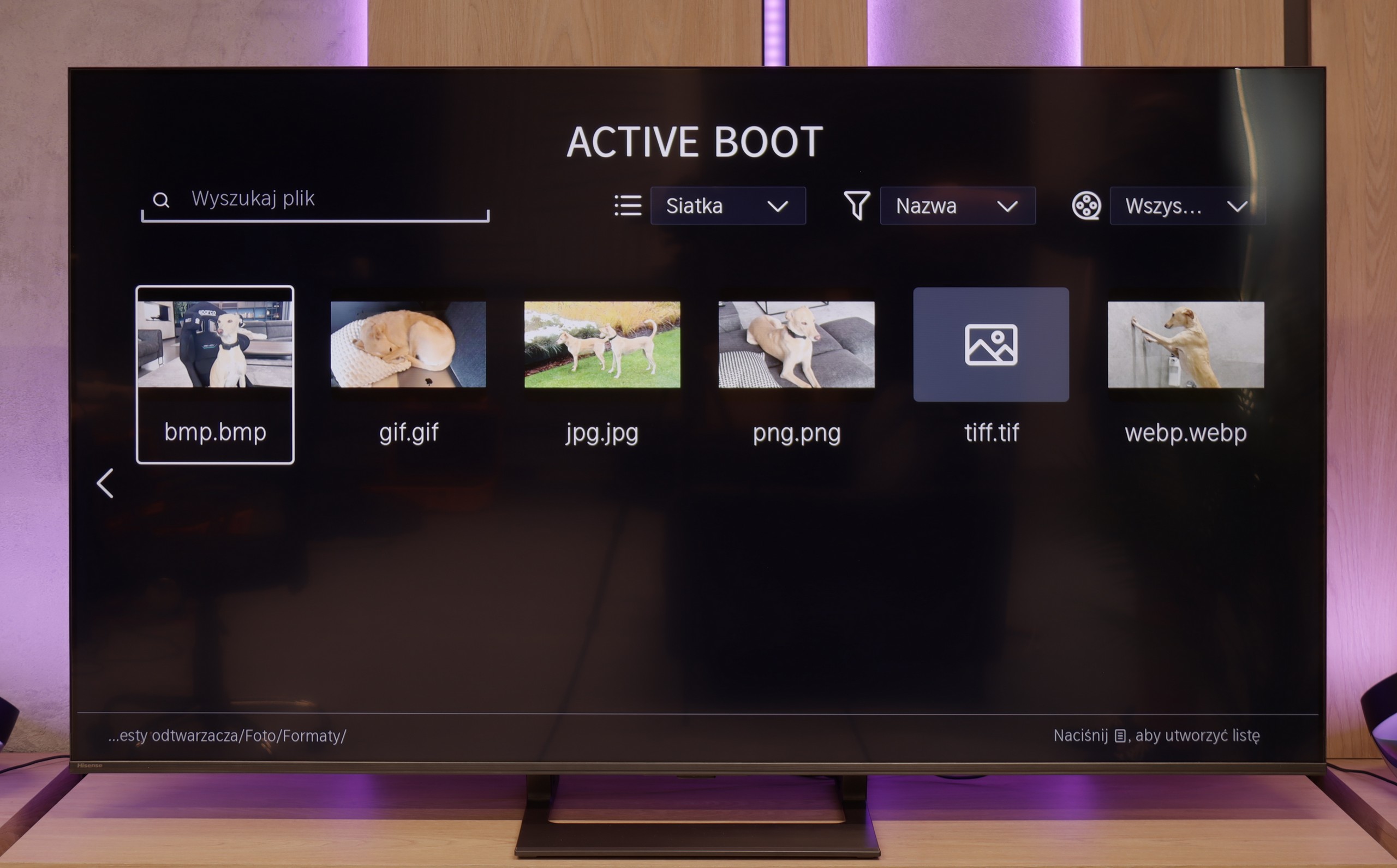
The Hisense S7NQ easily plays the vast majority of popular audio, image, and video formats. So why the relatively low rating in this category? Well, it’s because of software issues. This is another Hisense TV that didn’t allow us to open external subtitles in films. Regardless of whether we’re talking about the .ass, .srt, .txt, or .sub format – the subtitles simply didn’t appear.
The funniest (or rather, the most frustrating) part of it all is that in the menu, we find options to change the font color, size, and background… The problem is that the subtitles themselves are completely invisible.
The built-in media player in E8Q performs quite well. It supports most popular video and audio formats, and files from USB drives or external disks play without major issues. Polish characters? They are supported. Subtitles? They work. The only minor drawback is the occasional problem with displaying high-resolution images – especially those from cameras or smartphones. So if you plan to show vacation photos on a large screen, it’s worth checking in advance whether they will all load correctly from the drive’s memory or USB stick.
Apps
7.7/10
7.7/10














































Sound
6.3/10
5.5/10
- Subjective sound quality:6.3/105.5/10
- Dolby Digital Plus 7.1:
- Dolby True HD 7.1:
- Dolby Atmos in Dolby Digital Plus (JOC):
- Dolby Atmos in Dolby True HD:
- DTS:X in DTS-HD MA:
- DTS-HD Master Audio:
When it comes to sound, it presents itself... like a television on the wall – that is, rather flat. Despite the use of a 2.0.2 speaker setup with a total power of 36 W, we cannot speak of any exceptional sound. But as is often the case – purchasing even the simplest soundbar can dramatically change the situation.
On the plus side, it must be noted that it supports practically all popular Dolby and DTS codecs. This way, we can easily connect the television to a home theater system without having to fiddle with settings or audio conversion.
Unfortunately, the Hisense E8Q did not leave the best impression on us. Although on paper it has speakers with a power of 40 W (which is only slightly less than the 50 W in the U7Q), in practice, the difference is significant—and unfortunately not in favor of the E8Q. During testing, it quickly became apparent that something was off. When the volume was raised above 40-50%, the entire back housing began to resonate, and unpleasant crackling sounds emerged from the television. Even during regular viewing, it was hard not to notice this, and definitely hard not to hear it. In this form, it is difficult to talk about listening comfort. We do not rule out that this was a problem with a specific test unit, but nonetheless—it is worth keeping this in mind. If good sound is important to you, consider connecting a soundbar or… stick with the U7Q, which performs significantly better.


